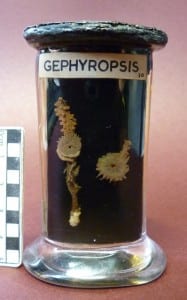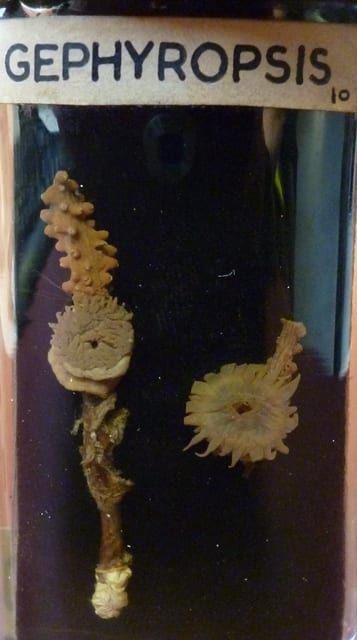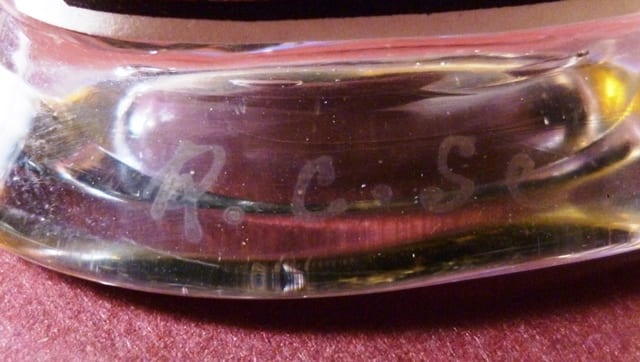Specimen of the Week 193: A very confused anemone
By Mark Carnall, on 22 June 2015

Image of LDUCZ-C1445 Amphianthus dohrnii on Eunicella verrucosa from the Grant Museum of Zoology UCL
Specimen of the week is the Grant Museum’s weekly blog series focusing on one of the 68,000 specimens in the collection. When it comes to my turn to write one, I normally try to choose a specimen that otherwise might be overlooked within the crowded cases. Whilst looking for a specimen to focus on this week, I found these lovely specimens, labelled as a fossil ostracod (an amazing group of crustaceans) and on display with the peanut worms and brachipods, whilst resembling anemones. What’s the story here? Hopefully this blog post will cure the case of mistaken identity.
This week’s specimen of the week is…
** Sea fan anemone Amphianthus dohrnii**
1) Anemone the enemy? To further compound the confusion around this specimen there’s actually two kinds of animal in this jar. Amphianthus dohrnii, the two little circles of tentacles seen below, is a small anemone that likes to set up home, exclusively on the stems of gorgonian corals. A.dohrnii is found in the northeastern Atlantic Ocean and the West Mediterranean Sea and is found in waters around Scotland, Ireland and England. In the northern part of their range they settle on the northern sea fan and in the southern part of the range it settles on the pink sea fan. These specimens are both on stalks of the pink sea fan, Eunicella verrucosa so the assumption is these are from the southern end of it’s range.

Image of LDUCZ-C1445 Amphianthus dohrnii on stems of Eunicella verrucosa from the Grant Museum of Zoology UCL
2) Strange reproduction As with the vast majority of animals, there are a lot of mystery around how sea fan anemones sexually reproduce, if they do at all. They can reproduce asexually by a grim process called basal laceration. As the anemone creeps along a gorgonian coral, pieces of the anemone shed off and develop into new miniature anemones.
4) Vanishing Act Sadly, this species of sea fan anemone seem to be disappearing from the British coast. They were commonly recorded in the past and were found as far east as the Thames Estuary, they now seem to be in decline. They are possibly completely absent from the Mediterranean Sea and have a marked decline within the UK since the 1930s. Their decline is due to a number of depressingly familiar factors. Their preferred corals to live on are disappearing as a result of collection for souvenirs in the 20th Century, the cooling of British coastal waters, pollution from human activity and damage from fishing practices. The pink sea fan is listed as vulnerable by the IUCN and currently fully protected by European regulations. Although not protected to the same level, A.dohrnii are listed as a UK Biodiversity Action Plan (UK BAP) priority species and their conservation goes hand-in-hand with their pink sea fan hosts. Sadly, there has been little recording and reporting of this species and the true extent of their distribution and possible decline is based on scant data.
3) Mistaken identity So how does this specimen find itself named as a crustacean and in with the worms? The rather prominent label attached to the jar (poor museum documentation 101), is an old name for these animals that confusingly was re-appropriated for an extinct crustacean in 1982. As for the odd location in the museum, let’s attribute this to ‘exhibition curation drift’. You’ll be pleased to know that this situation has now been rectified and this specimen can now be found alongside anemone and coral relatives.
5) A Royal Specimen? The base of the jar for this specimen is etched R.C.Sc. implying that this specimen was once part of the Royal College of Science. The Royal College of Science was founded in 1845 under the auspices of Prince Albert and was one of three institutions that were merged in 1907 to form constituent colleges of what is now Imperial College London. We have a large part of the collection from Imperial College London which came to UCL in the 1980s.
References
Joint Nature Conservation Committee. 2010. UK Priority Species data collation Amphianthus dohrnii version 2. http://jncc.defra.gov.uk/_speciespages/91.pdf
Mark Carnall is the Curator of the Grant Museum of Zoology
2 Responses to “Specimen of the Week 193: A very confused anemone”
- 1
 Close
Close



Fascinating post! Amphianthus dohrnii was described eighteen years after the publication of “Actinologia Britannica”, the master work on sea anemones and corals by P.H.Gosse. I wonder what Gosse would have made of the association between the two organisms, given that he was an affirmed Creationist?